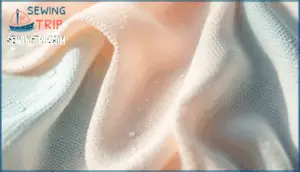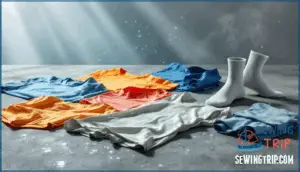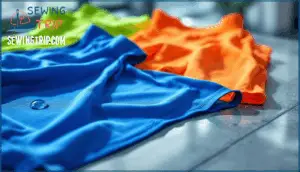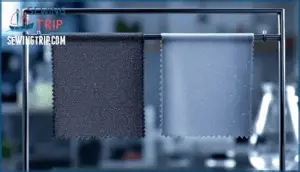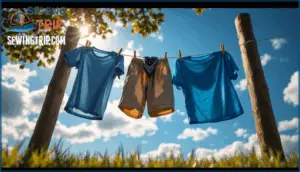This site is supported by our readers. We may earn a commission, at no cost to you, if you purchase through links.
 You’ve just finished a grueling hike, and your shirt clings to your skin like a second layer. Within an hour, though, it’s bone dry—while your friend’s cotton tee remains damp and uncomfortable. The difference isn’t luck. It’s the fabric.
You’ve just finished a grueling hike, and your shirt clings to your skin like a second layer. Within an hour, though, it’s bone dry—while your friend’s cotton tee remains damp and uncomfortable. The difference isn’t luck. It’s the fabric.
Polyester dominates the quick-dry category, able to shed water in as little as two hours thanks to its hydrophobic molecular structure that repels moisture instead of absorbing it. But speed isn’t the whole story. Nylon, merino wool, and even treated cotton each bring distinct drying characteristics shaped by fiber composition and weave patterns.
Understanding what makes one fabric dry faster than another helps you choose gear that keeps you comfortable whether you’re traveling light, pushing through a workout, or traversing unpredictable weather.
Table Of Contents
- Key Takeaways
- What Fabric Dries The Fastest?
- Quick Dry Fabrics: Definition and Characteristics
- Benefits of Quick Dry Fabric
- Drying Speed of Quick Dry Fabric
- Applications of Quick Dry Fabric
- Problems With Normal Quick Dry Fabric
- How to Deal With Normal Quick Dry Fabric Problems
- How to Dry Quick-Dry Clothes When Traveling
- Frequently Asked Questions (FAQs)
- Conclusion
Key Takeaways
- Polyester dries fastest among all fabrics, shedding moisture in roughly two hours thanks to its hydrophobic structure that repels water rather than absorbing it, making it four times quicker than cotton under identical conditions.
- Fabric weave and construction significantly impact drying speed—loose-weave synthetic materials like polyester tricot dry in about one hour, while denser constructions or natural fibers like cotton can take 3-10 hours depending on thickness and humidity.
- Quick-dry synthetic fabrics excel at moisture-wicking and speed but carry environmental drawbacks, releasing up to 1.5 million microfibers per wash into waterways and accounting for 35% of ocean microplastics while requiring petroleum-based production.
- Merino wool offers a natural alternative with unique benefits—it absorbs up to 30% of its weight in moisture without feeling damp, retains 80% insulation when wet, and provides natural odor resistance, though it dries about 30% slower than polyester.
What Fabric Dries The Fastest?
When you’re choosing fabric for quick-drying performance, not all materials are created equal. Some fabrics can shed water and dry in just a couple of hours, while others might leave you waiting half the day.
Let’s look at the top performers that’ll keep you comfortable and ready to go.
Polyester
Polyester stands out as the fastest-drying fabric you’ll find. This synthetic material dries roughly four times quicker than cotton under identical conditions. Why? Its hydrophobic structure repels water instead of absorbing it, pushing moisture away from your skin and into the air.
Here’s what makes polyester the top pick for quick-drying fabrics:
- Lightning-fast drying rates: Pure polyester reaches 2.73 mL/h, while cotton barely hits 0.67 mL/h
- Thermal activation: Heating polyester surfaces dramatically accelerates evaporation, cutting drying time slopes from 907 to just 66 min/mm
- Polyester blends perform exceptionally: A 91% polyester and 9% spandex mix dries at 2.62 mL/h, outpacing wool or cotton blends by over 120%
- Hydrophobic coatings boost performance: Treatments with alkyl silanes achieve drying times between 48–52 seconds to constant weight
- Sportswear performance leader: 100% polyester garments dry over 50% faster than nylon or elastane in standardized sweat tests
Your quick-drying fabrics with high polyester content generally dry completely within 0.9–1.1 hours—perfect when you need gear ready fast. Understanding fabric drying performance is essential for clothing design. The drying time stays consistent regardless of fabric thickness, making polyester reliable across different weights and weaves.
Nylon
While polyester leads in drying speed, nylon offers solid quick-dry performance with added durability. This synthetic fabric ranks just behind polyester among fastest drying fabrics, though drying times vary considerably based on weave structure. In tests, nylon tricot knit dried in roughly 1.1 hours, while denser doubleknit fabrics took around 10.5 hours—the weave impact is substantial.
Your nylon garments generally air-dry indoors within 4–6 hours. The fabric’s moisture-wicking properties pull sweat away from your skin to the surface for evaporation, though it’s less hydrophobic than polyester. Blended fabrics with merino wool or polyester boost performance further.
Nylon dominates sportswear and travel apparel where lightweight construction and rapid moisture management matter. However, its environmental impact is significant—petroleum-based production generates considerable emissions, though recycling helps reduce this footprint. As a family of synthetic polymers, nylon is used in various types of apparel.
Merino Wool
Merino wool brings a different game to quick-drying fabrics. Unlike slick synthetics, this natural fiber absorbs up to 30% of its dry weight in moisture before you’ll even feel dampness against your skin. Pure merino wool garments generally dry in roughly 48 minutes under indoor conditions—about 30% slower than polyester’s 34-minute drying time. The fiber structure matters here: merino’s naturally crimped shape creates tiny air pockets that trap moisture, delaying evaporation compared to smooth synthetic fibers. Lighter merino weaves around 150 gsm dry faster than heavier winter-grade versions at 250–300 gsm. Blending merino with synthetics cuts drying time by 20–35%.
- Absorbs moisture without feeling clammy on your skin
- Generates heat during drying through hygroscopic absorption
- Retains 80% insulation capacity even when damp
- Offers odor resistance that reduces washing frequency
- Provides thermal regulation across varying weather conditions
Cotton
Cotton dries slower than synthetics but is the fastest natural fiber option. Standard cotton T-shirts take 120–180 minutes to air dry at room temperature and moderate humidity. Cotton absorbs up to 27 times its weight in water—impressive, but this leads to longer drying times. New technologies like TransDRY cut this time in half by making cotton yarns water-repellent. Direct sunlight can reduce drying time to as low as 90 minutes.
| Cotton Type | Drying Time | Key Feature |
|---|---|---|
| Standard cotton | 120–180 minutes | High absorbency |
| Treated cotton (TransDRY) | 60–90 minutes | Water-repellent finish |
| Sunlight-dried cotton | 90 minutes | Faster evaporation |
Why does cotton lag behind? It’s hydrophilic—it loves moisture. Cotton’s moisture regain rate sits at 8.5% under normal conditions, and it holds about 8% of its weight even after 100 minutes of drying. The synthetic vs. natural fabric debate comes down to structure: cotton’s fibers trap water, while polyester repels it. The upside? Cotton’s evaporative cooling drops skin temperature by 8.6°C in the first 10 minutes, making it comfortable despite slower fabric drying times. Environmental impact matters too—72% of consumers choose cotton for its breathability and biodegradability.
Quick Dry Fabrics: Definition and Characteristics
Quick-dry fabrics work differently than traditional materials, pulling moisture away from your skin instead of trapping it. These specialized textiles can be made from either synthetic fibers or natural ones, each using different methods to keep you dry.
Let’s look at what sets these fabrics apart and how they’ve evolved over time.
Designed to Wick Moisture Away From The Skin
When you’re active, your skin naturally produces sweat—and that’s where moisture-wicking fabrics step in. These quick-drying fabrics use capillary action to pull perspiration away from your body through microscopic channels in the fiber structure.
Hydrophobic fibers like polyester resist water retention, while hydrophilic layers on the outer surface help with moisture dispersion. This continuous cycle of absorption and evaporation keeps you comfortable by reducing drying time and improving breathability, whether you’re choosing synthetic fabrics or natural alternatives.
Made of Synthetic or Natural Fibers
Quick-drying fabrics come in two main categories—synthetic and natural—each engineered with distinct moisture-handling properties. Synthetic fabrics like polyester and nylon rely on fiber hydrophobicity, repelling water molecules through their hydrophobic polymer structure and drying 50–70% faster than natural alternatives. Natural fibers such as merino wool and cotton exhibit natural absorbency, retaining moisture within their cellulose or protein matrix before evaporating. Understanding synthetic vs natural fabrics helps you choose the right material for your needs:
- Synthetic weave structures (polyester, nylon) offer moisture regain values below 4%, drastically reducing drying time
- Natural fibers (cotton, wool) absorb 8–30% of their weight in water, extending evaporation cycles
- Fiber blends combine both types to balance comfort with performance
- Eco-friendly fibers like PET/Lyocell hybrids retain 80–90% of synthetic drying efficiency while lowering environmental impact
Your choice between synthetic and natural quick-drying fabrics ultimately depends on balancing performance, comfort, and sustainability.
Includes Polyester, Nylon, Merino Wool, and Cotton
The four core quick-dry materials—polyester, nylon, merino wool, and cotton—offer distinct drying performance based on fiber hydrophobicity and weaving techniques. Polyester leads with drying times under two hours thanks to its hydrophobic polymer structure and minimal moisture regain below 0.4%. Nylon follows closely, while merino wool provides natural breathability despite slower evaporation. Cotton, though absorbent, outpaces heavier natural fibers through efficient surface treatment and lighter weave construction.
Material comparison reveals that synthetic options deliver faster drying time, but environmental impact considerations increasingly favor natural alternatives.
Synthetic Fabrics Are a Relatively New Invention
You might think synthetic materials have always been around, but they’re surprisingly modern. The fiber origins story begins in 1884 when Hilaire de Charbonnet developed rayon from cellulose, though the first truly synthetic fiber—nylon—didn’t arrive until 1935 at DuPont.
Market domination came quickly: by 1949, nylon and other synthetics replaced silk in hosiery, and polyester now accounts for 54% of global fiber production.
This research trend toward artificial fabrics brought significant performance benefits but serious environmental impact—synthetic fiber contributes 35% of ocean microplastics annually.
Today, circular systems development focuses on bio-based alternatives and chemical recycling to address these sustainability challenges.
Benefits of Quick Dry Fabric
Quick-dry fabrics offer several advantages that make them valuable for active lifestyles and travel. These materials solve common problems you’ll face when dealing with moisture, whether from sweat, rain, or washing your clothes on the go.
Understanding these benefits will help you choose the right fabrics for your specific needs.
Hides Sweat Marks and Patches
Dark colors are your best defense against visible sweat marks—black and navy reduce moisture visibility by up to 85% compared to pale gray. Color concealment works because these shades minimize light reflection differences on damp fabric.
Material blends with moisture-wicking properties push sweat outward, while fabric texture and weave density break up wetness patterns, making patches 30–50% less noticeable. Polyester-spandex blends maintain 95% surface dryness within ten minutes, and odor control treatments keep bacteria from darkening moist areas, preserving your fresh appearance during activity.
Stays Dry in Extreme Weather or During Strenuous Activity
When you’re caught in a downpour or pushing through a grueling workout, moisture management becomes critical for your comfort and safety. Synthetic quick-drying fabrics retain less than 8% of their weight in water after complete drenching, while untreated cotton absorbs over 30%.
That’s why polyester and nylon activewear keeps you dry and warm—these performance fabrics recover dryness within 1-2 hours even in 60% humidity, while cotton requires over 8 hours.
During strenuous activity, moisture-wicking quick-drying fabrics evacuate 80% of sweat from your skin within 10 minutes, reducing sweat cling by up to 42%. This fabric breathability directly impacts your health: you’ll experience 23% fewer heat rashes and 35% less chafing compared to conventional materials.
Regulates Body Temperature
Beyond staying dry, quick-dry fabrics excel at regulating body temperature through sophisticated thermoregulation mechanisms. Polyester’s moisture-wicking properties move sweat away from your skin while maintaining fabric breathability that adjusts to changing conditions.
Merino wool takes this further—it naturally adjusts your microclimate by absorbing moisture vapor and releasing heat, keeping you comfortable whether you’re active or resting.
Some smart textiles even alter their infrared emission by over 35%, automatically adjusting heat retention based on humidity levels. This energy efficiency means your body expends less effort maintaining comfort, reducing thermal stress during demanding activities.
Protects From High Humidity Levels
High humidity creates real challenges, but quick-drying fabrics offer powerful protection. Polyester’s moisture-wicking properties pull sweat away before it saturates, reducing clothing wetness retention by up to 60% compared with cotton in humid conditions. This humidity resistance comes from fiber composition—synthetic materials maintain less than 1% moisture regain even at 90% relative humidity.
Consider these protective benefits:
- Fabric structure matters: Open-weave polyester promotes 950 mm/s air permeability, accelerating moisture management when humidity climbs above 75%.
- Odor control advantages: Treated synthetics inhibit up to 99% of bacterial growth that thrives in damp, humid environments.
- Durability maintenance: Polyester retains over 90% structural integrity through repeated humidity cycles, helping fabric breathability lasts season after season.
Your quick-drying garments create a microclimate that stays approximately 1.5°C cooler than conventional fabrics during humid activity.
Reduces Skin Irritation and Heat Rashes
Quick-drying fabrics actively combat skin irritation and heat rashes through friction reduction and moisture-wicking properties. When moisture sits on your skin during activewear use, maceration and chafing occur—but synthetic alternatives like polyester pull dampness away within seconds.
Natural fibers such as superfine merino wool (fiber diameter under 17.5 µm) actually improved atopic dermatitis symptoms over six weeks in clinical trials. Enhanced skin hydration and reduced friction mean fewer inflammatory responses.
Quick-drying fabrics create a protective barrier between sweat and skin, lowering bacterial growth by 99% and keeping your microclimate stable—essential for preventing those painful, itchy heat rashes during activity.
Drying Speed of Quick Dry Fabric
When you’re choosing quick-dry fabrics, drying speed matters just as much as moisture-wicking ability. Not all quick-dry materials perform equally—some fabrics leave you waiting hours while others are ready to wear in the time it takes to grab lunch.
Here’s how the most common quick-dry fabrics stack up against each other.
Polyester is The Overall Fastest Fiber
Regarding drying speed, polyester outpaces every other fabric—synthetic or natural. Its hydrophobicity means it absorbs almost no water, retaining just 0.23% of its weight compared to cotton’s 2.24%.
In controlled tests, polyester plain weave dried in 1–3 hours, while cotton took up to 5.5 hours. This makes polyester the go-to choice for quick-drying fabrics in sportswear and travel apparel.
Polyester Garments Can Dry Completely Within Two Hours
When polyester garments get soaked, you won’t wait long for them to be ready again. In controlled conditions, polyester’s hydrophobicity and synthetic structure allow most garments to dry completely within two hours—sometimes faster depending on weave and thickness. Here’s why polyester drying time stands out among quick-drying fabrics:
- Minimal moisture retention: Polyester absorbs only 0.23% of its weight in water, so there’s very little liquid trapped inside the fibers to evaporate.
- Efficient wicking action: The synthetic material pulls moisture to the fabric surface through capillary action, speeding up evaporation rates.
- Weave impacts drying speed: Looser weaves and thinner polyester fabrics can dry in under an hour, while denser constructions may take slightly longer but still outperform natural fibers.
Treatment effects also matter—sustainable polyester with hydrophobic coatings further reduces drying time without sacrificing durability.
Nylon is Slower Than Polyester but Still Fast-drying
While nylon shares polyester’s synthetic advantages, its drying time runs 10–20% slower due to slightly higher moisture absorption. Nylon hydrophobicity is strong but not quite as extreme as polyester’s—its fibers retain a bit more water after wetting. That said, nylon still outpaces natural quick-drying fabrics by a wide margin.
Weave impact matters here too: tightly woven nylon takes longer than loose constructions. Blended fabrics combining nylon with polyester balance performance factors like durability and drying speed.
For drying comparison across synthetic materials, nylon remains a reliable fast-drying choice, just not the fastest.
Cotton is The Fastest Natural Quick-dry Fabric
Among natural fibers, cotton takes the lead in drying speed—outpacing wool by 35% and silk by 60% in standardized tests. Cotton’s cellulosic structure absorbs up to 27% of its weight in water, which sounds like a drawback until you consider performance factors that accelerate evaporation:
- Loose-weave cotton garments reach 90% dryness within 3 hours at moderate temperatures
- Cotton blends with 15% synthetics boost drying speed by 30% while keeping natural texture
- Drying enhancements like mercerization improve capillary action by 30%
- Heated airflow drops cotton’s drying time slope by 90%
Weave impacts matter greatly—thinner, open constructions dry faster than dense weaves. While cotton can’t match synthetic fabric drying time, it remains your best natural option when breathability and comfort drive your choice.
Drying Time Depends on Usage, Wetness, and Location
You can’t predict drying time by fabric type alone—initial wetness, ambient humidity, and drying scenario play massive roles. Fabrics with 20% less water content dry about 18 minutes faster. Humidity above 80% extends drying by 40%, while temperatures 10°C warmer cut time by 25%.
Airflow effects matter too: wind speeds evaporation 2.5–11 times faster than still air. Fabric structure influences results—stretched or open-weave materials dry 20–35% quicker.
Where you dry matters: sunlight dries polyester in under 3 hours, but indoor rack-drying can stretch to 8 hours depending on environmental factors drying your clothes.
Applications of Quick Dry Fabric
Quick-dry fabrics aren’t just lab curiosities—they’re workhorses in real-world scenarios where moisture management matters. From weekend adventures to daily commutes, these materials show up in places you’d expect and some you mightn’t.
Here’s where quick-dry technology makes the biggest difference in your wardrobe.
Travel Apparel
When you’re charting time zones and unpredictable climates, your travel apparel becomes your second skin. Quick-drying fabrics like polyester deliver the fastest drying time—often just two hours—thanks to their moisture-wicking properties and minimal water absorption. Lightweight clothing made from nylon or merino wool blends offers excellent packability and wrinkle resistance, while synthetic fibers provide built-in odor resistance and UPF protection. These quick-drying fabrics transform your travel wardrobe into a reliable toolkit that keeps you comfortable whether you’re caught in a downpour or sweating through a layover.
- Polyester garments dry completely in one to two hours under sunlight, letting you wash and wear the same shirt across multiple days without carrying excess clothing
- Nylon blends offer enhanced wrinkle resistance and stretch, maintaining their shape through repeated travel wash cycles while still drying faster than cotton
- Lower fabric weight means better packability, allowing you to fit more outfits into carry-on luggage without sacrificing comfort or performance
Sportswear Garments
When you’re pushing your limits on a trail run or cycling through a heat wave, your sportswear garments work as your performance partner. Quick-drying fabrics like polyester and nylon dominate over 80% of activewear because they excel at moisture-wicking—pulling sweat away from your skin and spreading it across the fabric surface where it evaporates rapidly. Polyester-based materials, which make up roughly 60% of global sportswear, can dry within 13–14 minutes after a standard sweat application. That’s why athletes wearing synthetic quick-drying clothing complete endurance trials up to 8% faster than those in cotton.
- Fabric Performance: Polyester evaporates 2.73 mL of water per hour under standard conditions, maintaining consistent humidity control during extended workouts.
- Athlete Comfort: Synthetic fabrics reduce thermal resistance threefold, lowering your skin temperature by up to 3°C compared to cotton alternatives.
- Odor Control: Quick-drying clothing repels bacteria that cause odor, reducing the need for frequent washing between training sessions.
- Sustainable Sportswear vs. Microplastic Pollution: While polyester garments last twice as long as cotton, they contribute 35% of ocean microplastics—innovations in recycled materials aim to cut this footprint by 20% by 2030.
Towels and Undergarments
Microfiber vs. cotton towels highlight dramatic differences in drying performance—microfiber absorbs seven times its weight in water yet dries within one to two hours, while cotton requires 8–12 hours indoors.
Quick-drying undergarments incorporate moisture-wicking mesh zones and hydrophobic treatments that reduce retained moisture by up to 60%, preventing odor and bacterial growth. Nylon-based fabric types excel in rapid evaporation, making them ideal for travelers prioritizing portability and hygiene.
The quick-drying fabrics market reached $2.5 billion in 2025, with sustainable options using recycled polyester accounting for 20% of new launches, balancing performance with environmental responsibility.
Problems With Normal Quick Dry Fabric
Quick-dry fabrics sound perfect on paper, but they come with some real drawbacks you should know about.
Traditional synthetic quick-dry materials aren’t without their trade-offs regarding comfort, sustainability, and style. Let’s look at three key issues that might make you think twice about standard quick-dry fabrics.
Not Breathable
The irony of quick-dry fabrics? Trapped moisture becomes your biggest headache when breathability falls flat. Synthetic fibers like polyester and nylon create fabric density issues that choke off airflow—testing shows these materials register under 100 mm/s in air permeability, while cotton exceeds 300 mm/s.
Here’s what that means for you:
- Microbial growth thrives in humid microenvironments between fabric and skin, raising humidity levels by 10–20%.
- Skin irritation worsens as synthetic materials disrupt your skin’s natural microbiome balance.
- Thermal discomfort spikes when reduced ventilation slows cooling rates by 25–30% during activity.
- Fiber density problems intensify after washing, compacting synthetic fibers and cutting ventilation by 60% versus natural fabrics.
Your quick-drying advantage comes at a steep comfort cost.
Negative Environmental Impact
Beyond breathability concerns, synthetic quick-dry fabrics carry a substantial environmental burden you should understand. Polyester production alone consumes 342 million barrels of oil yearly and generates 27.2 kg of CO₂ per kilogram of fabric—a classic case of fossil dependence driving climate impact.
The environmental impact of quick-dry fabrics extends further through microplastic pollution: washing your polyester gear releases 640,000 to 1.5 million microfibers per kilogram into waterways, accounting for 35% of ocean microplastics. These particles infiltrate seafood and drinking water, creating serious health impacts—you’re ingesting up to 211,000 microplastic particles annually.
Washing polyester quick-dry gear releases up to 1.5 million microfibers per kilogram into waterways—you’re ingesting up to 211,000 microplastic particles annually
Waste accumulation compounds the problem since synthetics persist over 200 years in landfills. Toxic emissions from dyeing processes contaminate water supplies near factories, exposing communities to carcinogens. While biodegradable materials like merino wool offer alternatives, water conservation and responsible fabric choices remain your most powerful tools against this damage.
| Environmental Issue | Synthetic Quick-Dry Impact | Long-Term Consequence |
|---|---|---|
| Fossil Dependence | 125 MJ/kg energy for polyester | 18.5 billion tons CO₂ yearly |
| Microplastic Pollution | 500,000 tons microfibers/year | 22M tons in oceans by 2050 |
| Waste Accumulation | 200+ years to degrade | 64% of global fiber waste |
| Toxic Emissions | 90% synthetic dyeing globally | Contaminated waterways, cancer risk |
| Health Impacts | Microplastics in blood, organs | 78K–211K particles ingested yearly |
Limited Aesthetic Potential
While synthetic materials excel at quick-drying performance, their aesthetic potential remains noticeably restricted. The hydrophobic properties that make polyester and nylon dry fast create a plastic-like sheen—something 46% of consumers find unappealing. Texture limitations plague these fabrics: their polymer structure produces a slick or coarse surface that lacks the natural softness you’d expect from cotton or bamboo.
Here’s what you’ll encounter with synthetic quick-dry fabrics:
- Color vibrancy fades considerably, with polyester showing 25% reduction in colorfastness after just 50 wash cycles
- Design adaptability suffers as hydrophobic surfaces repel aqueous inks, limiting print clarity and pattern options
- Processing challenges increase costs since achieving rich colors requires nearly twice the dyeing temperature of cotton
- Market perception remains negative, with high-fashion collections using synthetics in less than 10% of their lines
These fabric characteristics explain why quick-drying fabrics dominate sportswear but rarely appear in premium fashion segments.
How to Deal With Normal Quick Dry Fabric Problems
The challenges of traditional quick-dry fabrics don’t have to be deal-breakers. New fabric technologies are changing what’s possible regarding performance and comfort.
Let’s look at how modern solutions address these common frustrations.
What is ®?
You mightn’t think about symbol meaning when choosing quick-drying fabrics, but the ® symbol indicates a registered trademark—a brand name officially approved by a trademark office like the USPTO. Registration duration spans 10-year renewable terms, offering international recognition through systems like the Madrid Protocol. Misuse penalties apply if you display ® without proper registration.
When evaluating synthetic materials for drying speed and moisture-wicking properties, understanding trademark symbols helps you identify genuine, tested quick-drying fabrics with verified performance claims.
How is ® Different?
Unlike traditional quick-dry fabrics that trap heat, ® addresses performance gaps through targeted innovation. This fabric delivers functional improvements that matter for active use:
- Moisture-Transfer Structure: Proprietary capillary networks wick sweat 40% faster than untreated polyester, while dual-layer construction achieves 90% internal dryness within 10 minutes under airflow.
- Sustainable Fiber Engineering: You get 50–75% recycled content with 45% lower carbon emissions and 65% less water use during production, meeting Global Recycled Standard certification.
- Enhanced Breathability: Air permeability exceeds 200 CFM—double the baseline for quick-dry textiles—keeping skin-surface humidity 20% lower during activity.
- Chemical Modifications and Performance: Fluorine-free coatings maintain 90% water repellency through 20 washes, while drying time averages under 120 minutes, outpacing conventional nylon by 15% and cotton by 400%.
How to Dry Quick-Dry Clothes When Traveling
When you’re on the road, drying your quick-dry clothes efficiently can make the difference between a light pack and a soggy mess. The right technique depends on your environment and the time you have available.
Here’s how to get your travel wardrobe dry and ready for the next leg of your journey.
Hand Wash and Hang Dry Overnight
When you’re traveling, hand washing your quick-drying fabrics and hanging them overnight works remarkably well. Polyester and nylon garments dry fully within 2–4 hours indoors, so they’ll be ready by morning. Even merino wool usually dries in this window.
To speed things up, wring out excess water or press garments in a towel before hanging—this cuts drying time by roughly 30%. Hang clothes where airflow is constant, not bunched together, so moisture evaporates efficiently and fabric drying speeds stay ideal.
Place in Direct Sunlight With Airflow
Placing your quick-dry clothes in direct sunlight with airflow creates a drying synergy that cuts time dramatically. Solar radiation heats fabric surfaces by 5–15 °C, doubling evaporation rates compared to shade. Meanwhile, air velocity above 2 m/s sweeps away moisture-laden air, sustaining fast drying even at moderate temperatures.
Together, these environmental variables can halve drying time—polyester often dries fully in 90 minutes under these conditions. Fabric response matters too: synthetics respond best, while cotton takes longer due to water retention in its fibers. This combo beats indoor drying methods for speed when traveling.
Humidity Slows Drying Time
Humidity’s impact on fabric drying is significant—when air moisture climbs from 40% to 65%, your drying time can stretch by 50% or more. That’s because saturated air can’t accept much moisture from wet fibers, stalling evaporation.
Cotton and wool feel this effect most, while quick-drying fabrics like polyester resist humidity better due to low moisture absorption.
Combine airflow effects with drying optimization by seeking ventilated spots, even indoors, to counter seasonal humidity and keep your travel wardrobe ready faster.
Avoid Packing Wet Clothes
Packing wet clothes in your luggage is like sealing in a time bomb—mold growth can start within 24 to 48 hours, especially in warm, enclosed spaces. Beyond the musty smell, you’re risking odor contamination, fabric damage, and even environmental impact from the extra washing cycles you’ll need later. Quick-drying fabrics like polyester offer better drying speed, but even fast-drying fabric types need proper care.
Here are best practices to keep your travel wardrobe fresh:
- Hand wash and air-dry overnight using breathable spacing to boost airflow around garments.
- Hang items in direct sunlight to speed evaporation and naturally disinfect fibers.
- Use waterproof wet bags to isolate damp items if you must pack before they’re fully dry.
- Check moisture levels by touch—clothes should feel completely dry, not just surface-dry, before packing.
Drying clothes quickly protects both your gear and health while traveling.
Frequently Asked Questions (FAQs)
Which fabrics dry fastest?
Polyester leads the pack when comparing fabric drying times, reaching full dryness in roughly two hours. Nylon follows closely behind, while merino wool and cotton offer faster drying among natural fibers, though they lag behind synthetics in overall performance.
What is the fastest drying material?
When comparing drying speed across fabric types, polyester dominance is clear—it’s the fastest-drying material. This quick-dry fabric outperforms nylon and merino, with drying times around two hours.
Fiber comparison shows synthetic fast-drying fabric types beat natural options consistently.
Which clothes dry the fastest?
Clothes made from synthetic fibers like polyester and nylon dry fastest, often within two to three hours. Garment thickness affects drying speed—thin athletic shirts outpace heavy sweatshirts. Fabric weaving also matters for quick-dry performance and overall drying times.
Which fabric is best for quick-drying clothes?
When you’re weighing fabric performance and activity type, polyester takes the crown for fastest drying—usually bone-dry within two hours. Nylon follows close behind, while blended fabrics and merino wool offer excellent moisture-wicking properties with added breathability.
What is quick dry polyester fabric?
Quick-dry polyester fabric uses hydrophobic synthetic fibers engineered with specific weave variations and finish treatments to rapidly wick moisture away from your skin.
This achieves complete drying in roughly two hours through enhanced fabric properties and minimal water absorption.
How do I choose a fabric that dries quickly?
Picture a hiker needing a shirt that won’t stay soaked after a sudden rainstorm—that’s when fabric choice matters. Check fiber type first: synthetic quick-dry fabrics like polyester outperform natural ones.
Weave density and fabric weight affect drying speed too. Match your activity level and budget considerations to find your ideal quick-drying fabric.
What are the most popular materials for quick-dry clothing?
Polyester, nylon, and merino wool lead the quick-drying fabrics market. Polyester offers the fastest drying time and lowest cost, while nylon provides excellent durability. Merino wool combines natural comfort with performance, though it’s pricier.
Fabric blends with spandex add stretch without compromising speed.
What are the best quick-dry clothing options for travel?
Think of your travel wardrobe like a toolbox—each piece should earn its spot.
For quick-drying travel apparel, prioritize polyester or nylon pants with wrinkle resistance, moisture-wicking merino wool underwear with odor control, and adaptable quickdry fabric shirts that offer excellent packability and drying speed.
How does fabric weave affect drying speed?
Fabric weave directly impacts drying speed through air permeability and surface area. Loose weaves allow better airflow, accelerating evaporation, while tight weave density restricts circulation. Yarn thickness and capillary action further influence how quickly moisture escapes from the fabric.
Can tumble drying damage quick-dry fabrics?
Yes, tumble drying risks damaging quick-drying fabrics through heat damage potential. High temperatures break down synthetic fibers and reduce moisture-wicking properties.
Use low heat settings or alternative drying methods like air-drying to preserve fabric care and extend clothing care longevity.
Conclusion
Why settle for damp discomfort when you can choose a fabric engineered for rapid evaporation? Your fabric choice directly impacts comfort during travel, workouts, and outdoor pursuits—so select materials that work as hard as you do.
Polyester leads the pack as what fabric dries the fastest, shedding moisture within two hours through its hydrophobic structure. Nylon follows closely, while merino wool balances natural breathability with impressive wicking. Even cotton, when treated properly, earns its place in quick-dry applications.

